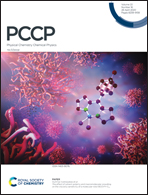Adsorption-induced co-assembly of hairy and isotropic particles†
Abstract
We use coarse-grained molecular dynamics simulations to study the behavior of polymer-tethered particles immersed in fluids of isotropic particles. Particles modified with weakly anchored, mobile ligands are considered. We discuss how the concentration of fluid particles affects the morphology of an isolated hairy particle. It is shown that hairy particles present different morphologies including typical core–shell, octopus-like and corn-like, depending on fluid–segment interactions and the fluid density. The mechanism of changes in the shape of hairy particles is explained. The reconfiguration of the polymer corona arises from adsorption of fluid particles “on chains”. The adsorbed fluid particles form bridges between the chains. This causes the mobile ligands to merge into clusters on the core surface. A part of the core remains empty so the hairy particle becomes a Janus-like object. We also study co-assembly in mixtures of hairy and isotropic particles. Depending on the strength of fluid–segment interactions, hairy particles with fluid particles trapped inside their coronas remain isolated or form mixed clusters of different structures. The aggregation of hairy particles results from the formation of bridges between chains belonging to different cores by fluid particles.



 Please wait while we load your content...
Please wait while we load your content...